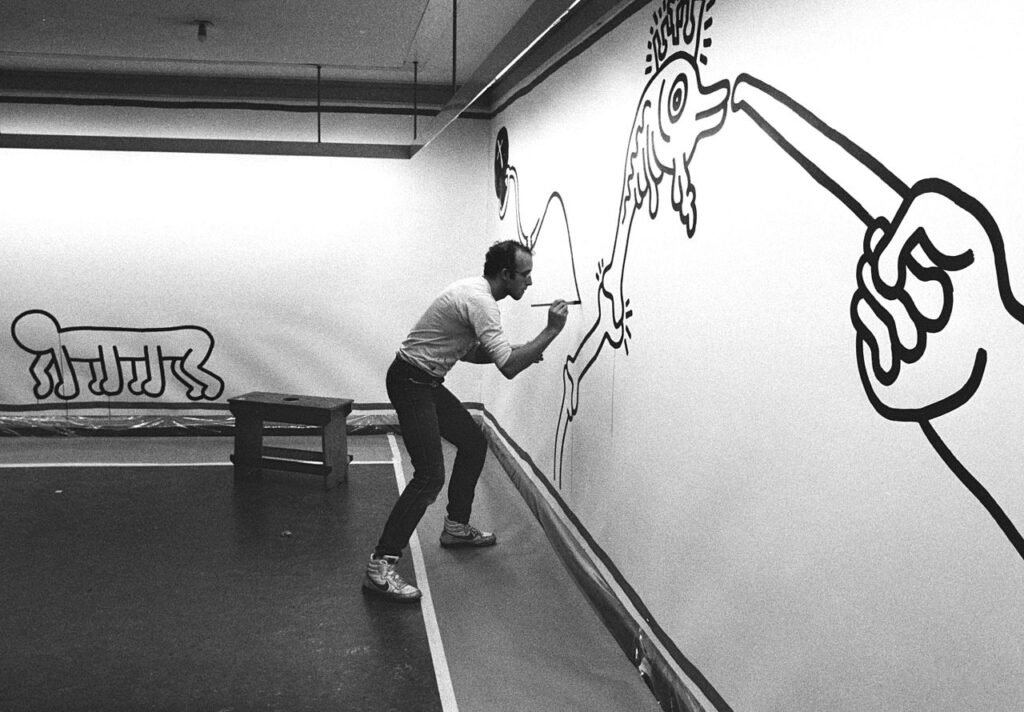Join us for a conversation with author Brad Gooch at the Jamestown Art Center on Saturday, May 4th at 4:00 PM.
TRANSCRIPT
Hernandez: What’s your first experience with Keith’s art? Where did you first see a Keith Haring piece?
Gooch: Well, I was around at the same time. I mean, I’ve been saying that I sort of Forest Gumped myself into this biography since Keith came to New York in 1978. He was living in the East village, mainly at First Avenue and First Street. I was at Bleeker and Bowery at that time. And so, so it intersects. I mean, at first with his work, the first thing I remember, that’s what you’re asking, was walking from the West village to the East Village with my lover, Howard Bruckner, and on the street corners stamped in graphite at every corner, was this sign that said, “Clones Go Home.”
Then I began seeing barking dogs, crawling babies, especially on a newsstand in Soho, either Prince Street or Spring. And all this is anonymous. So that’s what added to the mystery and interest of it. And then Keith Haring begins this project in chalk, drawing on these black matte rectangles in the subways, which is where advertisements would go. But between the Smirnoff ad and the next ad for “Oh! Calcutta!”, there might be a week or two of fallow time. So he would draw on this and then they would be covered over. So they were kind of impermanent drawings. This project went on for like five years. He did about 5,000 of these, which is one of the largest public art projects ever completed.
And so if you were going to the subway, there are millions of people in the subway. Not all of them paid attention to these ads, but lots of people did, and especially downtown. And for a while, then again, it was still a mystery and anonymous. There was a piece in the New York Post that called him Chalk Man. So this added to the aura of Keith Haring before there was a Keith Haring.
Hernandez: You have this beautiful book that you’re describing his life, but if you were to describe to the novice in just a couple of sentences, two or three sentences, who is Keith Haring? How do you describe him?
Gooch: Keith Haring was someone whose mission, I would say, was art for everybody. And so he devoted this kind of tenure. career, starting with drawings in the subway, but at the same time that he was making work that would show in galleries and museums, he was doing popular work. He started a pop shop. And now we all know these, even if we don’t know the name Keith Haring still, or much about his life, we recognize these kind of buoyant jumping around figures and these barking dogs and crawling babies. So he made a language. And then shared it with the world in all these different media.
Hernandez: As you said, you were experiencing as you go through the subways, as he was developing his style and really starting to, build himself up as an artist was in the subways and through the work he did paint, you know, drawing and painting and chalk on ads. But at what point did that all of a sudden become mainstream?

Gooch: Well, yeah, he becomes an art star. And I think by doing these subway drawings, he also does a sort of end run around the art world at the time. Someone who I interviewed, Diego Cortes, who was a curator at the time, said to me that the art world of the 70s that they came into, was like white people in white rooms drinking white wine. Keith expanded this greatly and so he didn’t need to go around to galleries and dealers with his slides to find an art gallery. He already had this whole following underground. So he does his first show at Tony Shifrazi gallery and he’s 24 years old. The opening of the show is carried on the NBC or CBS, sorry, Evening News with Dan Rather with Charles Osgood narrating the story about this 24 year old kid from Kutztown, Pennsylvania. And so there were hundreds of people at this opening. And it was very different from the usual opening.
Hernandez: What happened to him emotionally when he was diagnosed with HIV in 1987, and shortly after that with AIDS?
Gooch: well his first reaction, I mean he goes down to the East River and cries. I mean he has a, obviously, even though he’s been expecting such a diagnosis because people are falling to the left and right of him at that time. You know, it’s still a shock and he’s still initially sad about this and overcome emotionally about this, but very quickly, turns it around, and his response to AIDS becomes, was very different for the, in certain ways, for the times.
I mean, he decided to do an interview with Rolling Stone magazine, which was like a rock star move, and come out publicly as a PWA, a Person With AIDS. And this was at the time that Rock Hudson was dying of AIDS and refusing to admit it, where Donald Trump’s lawyer, Roy Cohn, practically came back from the grave to say that he had had pneumonia. so everyone is in denial. Obituaries at the time usually gave the cause of death as pneumonia and people didn’t seem to have personal lives. Haring very much becomes an activist immediately, in his work and his paintings are suddenly about silence equals death and he’s involved with ACT UP, an important protest activist organization about AIDS at the time.
And also in terms of his work, he doesn’t wither away, instead he sort of revs everything up and he does more and more and more work. And he’s working until the last few weeks of his life and doing large pieces. He did a big mural on the side of a church in Pisa, His last major work he does at Yoko Ono’s apartment is a triptych of the Last Judgment, which you can see in the Cathedral of Saint John the Divine in San Francisco and a cathedral in Paris. So he’s really working up to the end and traveling. So very aware of death and taking this proactive stance.
Hernandez: Was there anything that surprised you as you were researching and putting this book together and digging into his life.
Gooch: I would often in the first couple of years of writing this, I was asked by people, “So what did you find out that nobody knows about Keith Haring?” And I would say, what a serious artist he was, you know, which often led to disappointed looks from people, but it was. Well, you know, and following the line of him putting himself together as an artist and then tunneling through his life, creating so much work constantly. I mean, he just had an extraordinary work ethic and was, you know, very serious about his work and you now can see it when you look at these Haring works in museums. They still speak and they have a kind of freshness and you can see all these influences that he was constantly sponging up that go into the work.
Hernandez: What do you want people to take away from this book and how they view Keith Haring?
Gooch: Well, I think that, what I also sort of discovered along the way was that everyone can recognize a Keith Haring work. Not everyone knows they’re by Keith Haring. I mean, he’s so much part of the atmosphere of our life. And also people didn’t know that much about his life. Haring actually was sort of a private person and a bit detached. I mean, he wasn’t exactly like his jumping around figures. So the way in which someone, an artist actually lives, and in his case, how he overcame so many obstacles to get his work out there and how much he cared about it, And how he brought this kind of activism into it. All that is actually inspiring. And it seems very much of our times also. I sometimes think Haring’s work makes more sense now than it did when we first saw it in the 1980s.
Hernandez: Brad Gooch is a New York Times best selling writer and the author of the new biography, Radiant, The Life and Line of Keith Haring. Brad, it’s been such a fun time reading the book and getting to know an artist that I’ve known about. I’ve known his work, but I didn’t know anything about him, and I’ve learned something. I really appreciate it.
Gooch: Oh, great. It was great talking to you, Luis. Thanks.
Hernandez: And if you’d like to hear more, I’m going to have a longer conversation with Brad Gooch at the Jamestown Arts Center, Saturday, May 4th, at 4 p. m.






